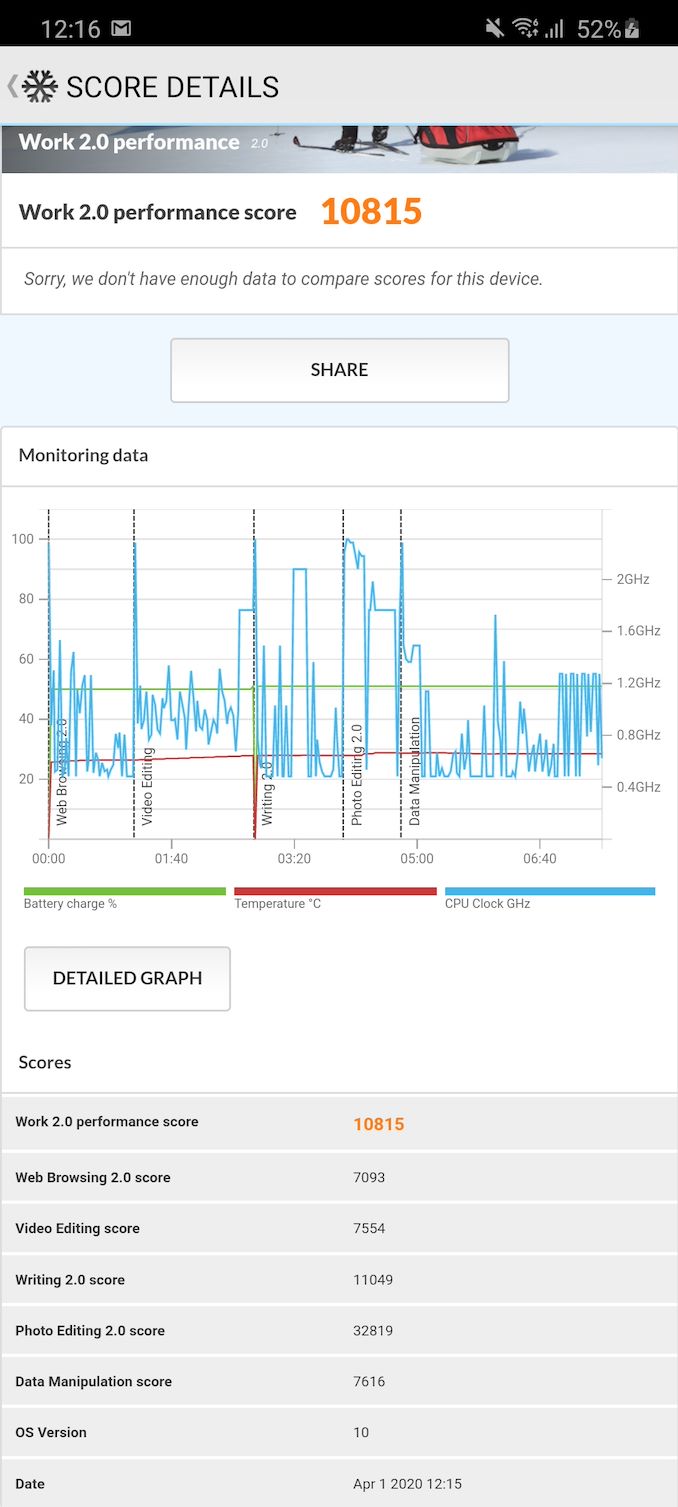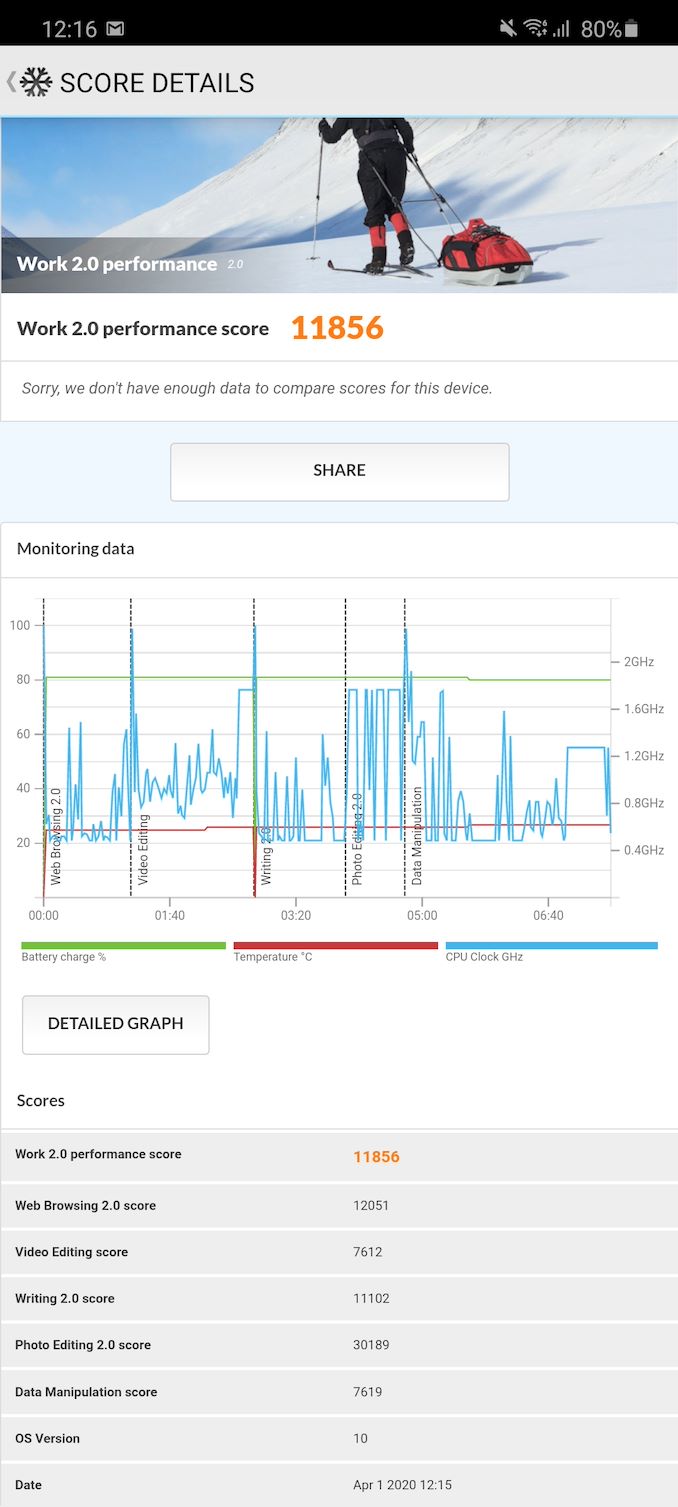The Samsung Galaxy S20+, S20 Ultra Exynos & Snapdragon Review: Megalomania Devices
by Andrei Frumusanu on April 3, 2020 9:30 AM ESTSystem Performance: 120Hz Winner
Although the peak CPU performance of the two Galaxy S20 SoCs isn’t all that different, what also matters is how the software decides to use that computing power. We’ve seen in the past that the DVFS and scheduler settings can have a very big impact on everyday performance of a device, sometimes even more so than the actual hardware. We’ve already quickly visited the Snapdragon 865 in the Galaxy S20 Ultra a few weeks ago, and we were very impressed by the performance and efficiency of the device. Now what remains to be seen how the Exynos 990 variant of the phone behaves.
Also at play here is the phone’s 120Hz display refresh mode. Samsung gives the option to choose between 60Hz and 120Hz in the display settings, with the latter naturally giving you more fluidity in applications. Beyond that, there’s also the matter of the device’s battery modes, in particular the difference between the default “Optimized” and “Performance” modes.
On past Samsung devices we’ve always tested the phones in their performance modes, as I hadn’t really noted much of a battery life difference between the two modes – and naturally we want to experience the full performance of a flagship device anyhow. This is still valid for the Snapdragon 865 Galaxy S20s, however the Exynos 990’s Performance mode is behaving weirdly and incurs quite a large power penalty, to the point that I would strongly recommend against using it. So the most practical comparisons for most people will be the Snapdragon Performance mode figures (P) against the default Exynos figures, at least for the S20 and at least for the current firmware versions.

Starting off in the web browsing test in PCMark, there’s a very clear performance difference between the two phones, however this isn’t just because the Exynos 990 somehow sucks, but because there’s a weird software configuration on the S20 Ultra.


Exynos 990 - Galaxy S20 Ultra 120Hz vs Galaxy S20+ 120Hz
Oddly enough the web browsing test is the most sensitive to a DVFS, scheduler, or Android task management setting difference between the Exynos S20 Ultra and the S20+. The latter here performs significantly better for some reason.

In the video editing test, the differences are minor, and in general the 120Hz results of the phones are clearly different to the 60Hz results. The test is generally V-sync limited here and isn’t all that representative of workloads anymore as most phones ace it nowadays. It’s again the Exynos in the 60Hz Performance mode which stands out of the crowd, getting better scores due to its extremely aggressive scheduling.

The Writing subtest is amongst the most important in the suite and most representative of everyday performance. Here the Snapdragon 865 is ahead of the Exynos by a good margin, and falls in line with the best scores we saw on the QRD865 in Performance mode. The Exynos, generationally, is also posting a good improvement over the Exynos 9820 of the Galaxy S10.

It seems SLSI has finally resolved their performance issues of their Renderscript drivers – either that, or the new Mali-G77 GPU is doing significantly better than the G76 in these workloads. Both variants of the S20 phones here clearly ends up with top performance scores, leading the pack ahead of all other Android devices.

In the Data Manipulation test, the scores are again quite good for both variants of the phone, however the Snapdragon 865 model does lead here, especially in the 120Hz mode. In fact, in this test it fares quite a lot better than the QRD865.

In the overall scores, both variants of the S20 Ultra are top performers. As a reminder, the Exynos 990 S20+ fared a bit better than our Ultra unit for some reason, but we’re opting to show the two Ultra scores here for best apples-to-apples between phones.
Web Benchmarks

In Speedometer 2.0, performance of the Exynos 990 chip isn’t all that much better than its predecessor, only sporting 12% increase. The Snapdragon variant on the other hand is 31% ahead of its S10 sibling, also posting notably better than what we had measured on the QRD865. It’s still far away from what Apple’s microarchitectures are able to achieve – the combination of strong CPUs along with better optimized browser JS engines is key to the iPhone performance.

In WebXPRT, the situation again favors the Snapdragon 865 variant of the phone by 17%.

Finally, in JetStream 2, the extend its lead to 24% which is quite large. Samsung’s custom CPU cores are particularly weak here and that’s likely due to the high instruction throughput of the test. I had found out their microarchitecture is quite weak with larger code sizes, for example unrolling loops will greatly handicap the performance of the Exynos CPUs whilst the Arm cores essentially see no big differences.
Performance Verdict: Both Winners, 120Hz Overshadows SoC Differences
Overall, I wasn’t disappointed with either variant of the S20. Both phones felt faster than Snapdragon 855 devices, the Snapdragon 865 variant of the S20 Ultra was just a little faster than the Exynos 990 variant.
The biggest improvement is user experience though it’s the 120Hz display mode. It’s just a fantastic addition to the phones, and really makes scrolling content that much more fluid. Along with the 240Hz touch input sampling rate of the phones makes these by far the most responsive and smooth experiences you can get on a mobile phone today.










137 Comments
View All Comments
iSeptimus - Sunday, April 12, 2020 - link
They really don't. 2 years max on updates and the security patches only come out when it is critical after that.My Galaxy Fold only just got One UI 2.1 and Android 10. The most expensive phone they do and they are already slowing down updates for it. Samsung suck at software.
MAGAover9000 - Tuesday, April 7, 2020 - link
Sounds like a positive TBH. I hate some of the updates.Omega215D - Friday, April 3, 2020 - link
That's for the maxed out S20 Ultra, what S10 are you comparing it to? There are the following additions to the S20 lineup: camera tech, 5G, battery capacities, mobile chipsets, display tech, etc. Now not everyone may find those attractive enough to jump on board that doesn't mean they have to buy the damn thing.Threska - Friday, April 3, 2020 - link
5G is probably the biggest push for cost, since 5G phones usually run in the $1,000 range.Andrei Frumusanu - Friday, April 3, 2020 - link
The Galaxy S20 and S20+ 4G variants have the same launch prices as S10 and S10+ - with the only caveat being that they're only available in certain markets, with the US missing from that list.So in that sense, the only thing you're paying extra for is the 5G.
FunBunny2 - Friday, April 3, 2020 - link
"5G phones usually run in the $1,000 range"I still don't get why anyone would pay for "5G". mmWave is barely extant. Verizon, for one, adverts pump up use in football stadiums (if we ever have such), 'so it must be great for you' kind of thing. while sub6 is barely perceptibly different LTE. Why? If there's ever a true build out of mmWave, it'll be in suburban subdivisions with plenty of street lights, no longer the norm. In cities, you'll need some sort of '5G' wifi inside any kind of building with a (massive?) dish on the roof. Ah cannaw change da laws of physic, capn.
shabby - Friday, April 3, 2020 - link
We don't have a choice, Qualcomm is forcing it onto us.s.yu - Friday, April 3, 2020 - link
Qualcomm's going with the flow of the industry, there's no way but forward ;)But anyway, the Luneburg lenses China Mobile showcased, if they're compatible with mmWave, and if they're even willing to sell them(the issue is cost and somehow they're able to make them much cheaper, cheap enough for civilian use), then they could drastically increase coverage at essentially the same power levels.
PeachNCream - Friday, April 3, 2020 - link
Yup, that's a lot to pay for something that you carry around on a daily basis and expose to the outdoor world including weather, impact, and theft. I know the TELCOs are hiding the cost inside monthly payments over the life of a contract so most buyers will not take note of the price over say an $800 dollar handset, but wow people are forking over a lot of their earnings just to carry around a status symbol that other people will stop caring about after a couple of months.FunBunny2 - Friday, April 3, 2020 - link
"wow people are forking over a lot of their earnings just to carry around a status symbol"why does a Ferrari cost 3 times a Ford (not the GT, of course)? because the capital investment to make either is nearly the same, but spread out over a fraction of units. same with "5G" phones. the capital to make all those specialized bits and pieces, whether Samsung made or bought it, is about the same, but separate, from the capital to make a moto G6, etc. but far fewer units. unlike the march to LTE, "5G" is more likely to be a toddler's waddle. with sky high prices as an added benefit.
there was a headline recently that the Swiss watch industry is on a ventilator, few have any need for such bling. can the bling smartphone be far behind? at least your scion can use that Patek Philippe in 50 years.